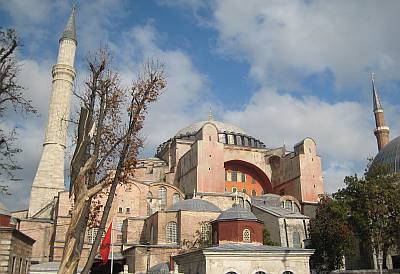The excitement is building for our Hagia Sophia recreation concert at Stanford this season. So much so, that just this week, two different publications have featured it.
Stanford Magazine goes into detail of how the concert came to be and how it works:
“The first step to recreating the auditory experience of Hagia Sophia was to reconstruct the path a human voice would have traveled 1,500 years ago. But that required access. After extensive negotiations with Aya Sofya Müzesi administrators, in 2010 Pentcheva was granted permission to record inside the building—with the stipulation that she use a distinctly nonmusical sound.
Inexpensive, portable and easy to deploy, a balloon was ideally suited to the purpose. “Balloon pops are convenient for probing the acoustics of a space, as they generate relatively uniform radiation patterns and consistent ‘N-wave’ waveforms,” says Abel.
Sound impulses propagate in all directions, interacting with obstacles along the way. Absorbed by some materials and reflected by others, they arrive at the listener in successive moments, creating overlapping waves that carry with them an imprint of the space.
Pentcheva stood beneath the great dome, two omnidirectional microphones clipped to the hair above her ears. Approximately 10 feet in front of her, a museum guard pricked the balloon while the microphones recorded the pop in stereo. “I was surprised at how loud it could be,” she recalls, noting that art historians tend to want to draw the least possible amount of attention to themselves. “A pistol shot is not the ideal.”
Back at Stanford, Abel processed and analyzed the recording to extract a signal—an acoustic fingerprint called the room impulse response—that gives Hagia Sophia its distinctive aura. He then constructed a computational model to apply that fingerprint to any piece of music, thereby transforming it such that the output is sonically identical to what it would have sounded like in the actual space.
Next, to recreate a choir performance, Abel would record individual singers and position them digitally within the virtual acoustic environment. In March 2011, his team recorded 13 members of Cappella Romana, a vocal group based in Portland, Ore., that specializes in early Christian music, singing three chants on the CCRMA stage. Kolar, who has been a recording engineer and concert sound designer for more than a decade, flew back from Peru to assist and advise….”
Read the full feature on alumni.stanford.edu!
Hagia Sophia Sings Again:
“The Hagia Sophia in Istanbul was one of the most influential and architecturally significant houses of worship in the medieval world. Built by Byzantine Emperor Justinian in the sixth century, the building has been a religious and political flashpoint ever since, starting as a Christian church, becoming a Muslim mosque, and now existing as a secular museum.
With its contentious past in mind, it’s no surprise that the current custodians have banned worship in the building; most unfortunately, the form of worship it was designed to amplify: singing…Cappella Romana’s virtual performance in Hagia Sophia will be presented in a custom-built space on the Stanford campus next February. And as far as Abel is concerned, the four-year project has given him much more than a quick listen to the past. “The space is telling you all these things about it as you’re listening,” said Abel. “It gave me an awareness of what architecture can do for humans.” — Utne.com



You must be logged in to post a comment.